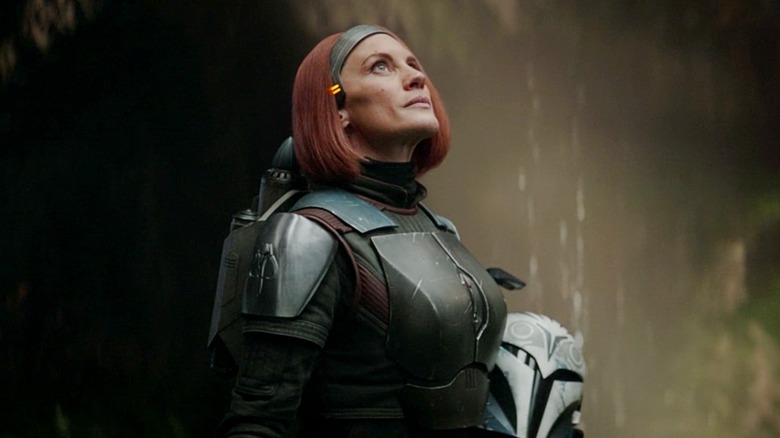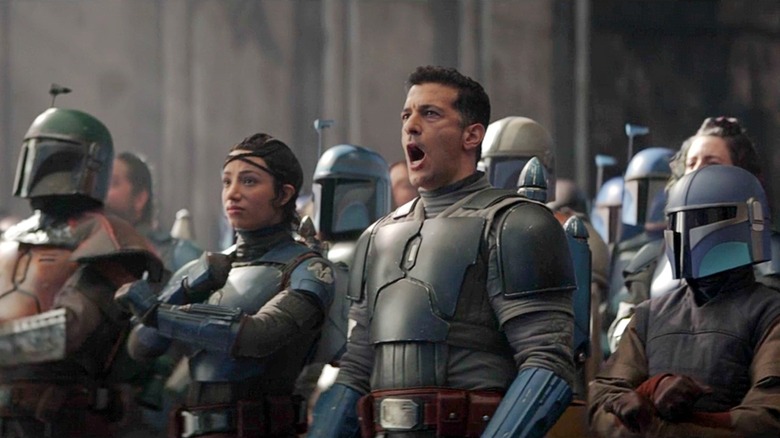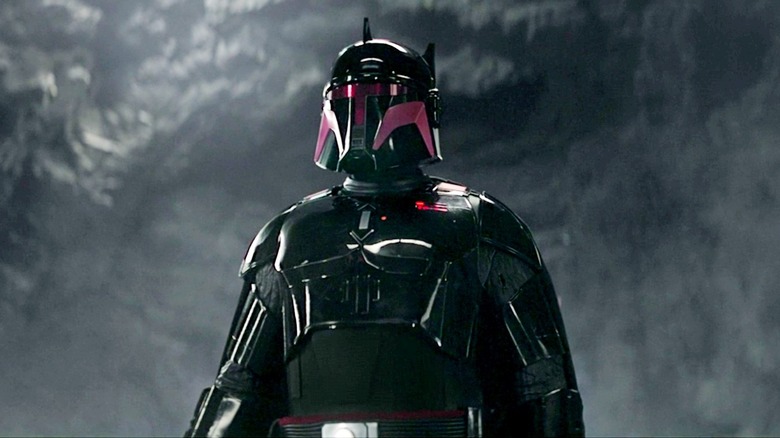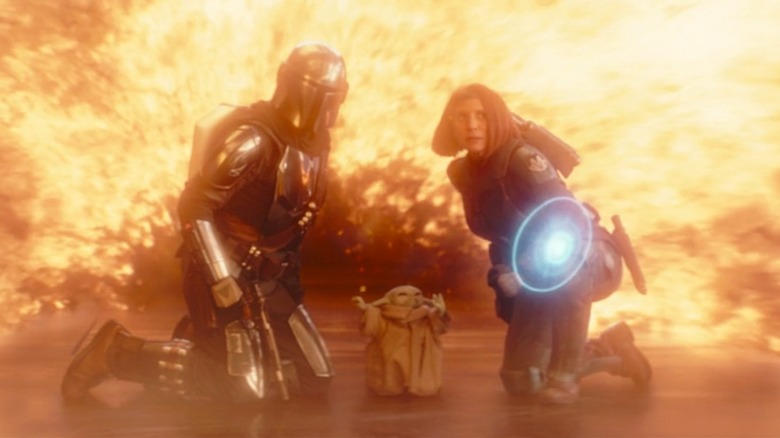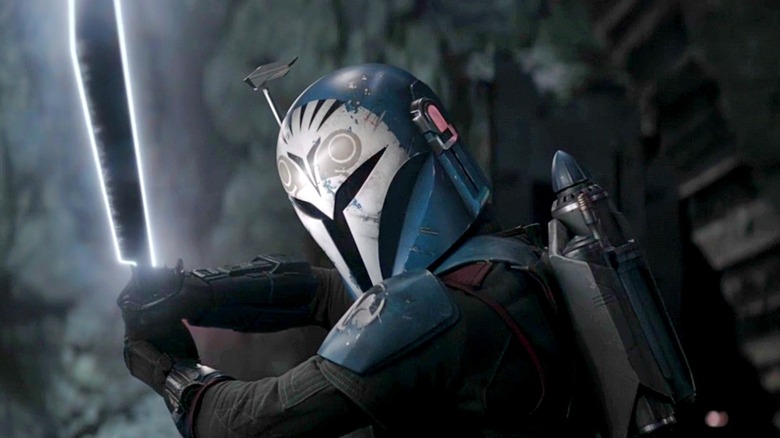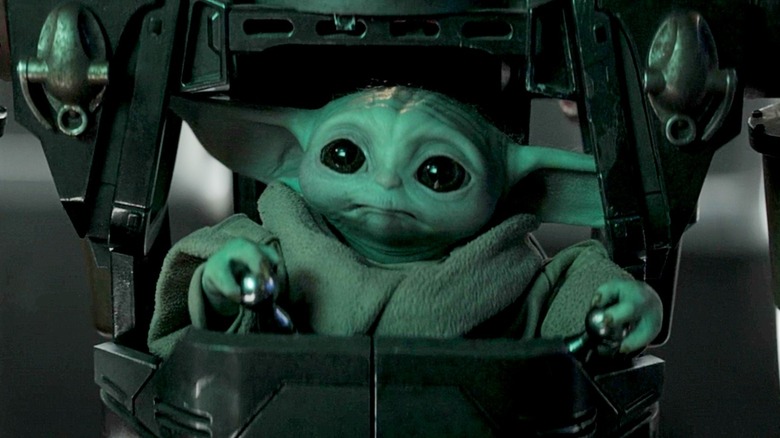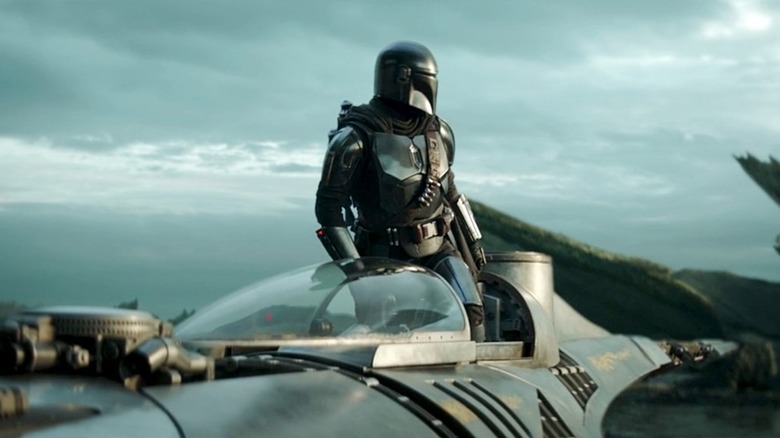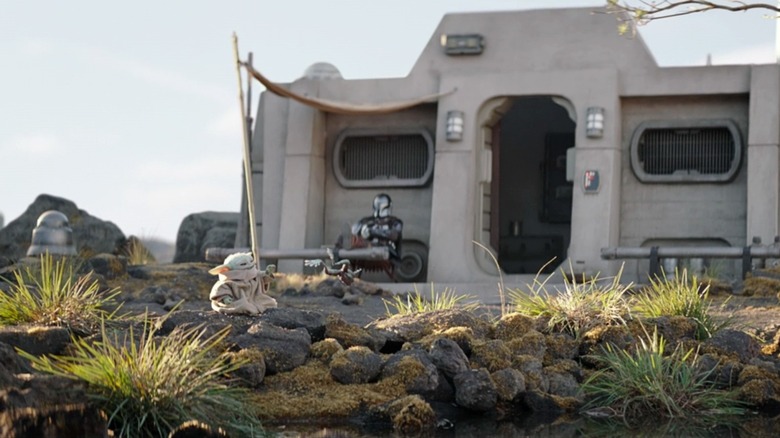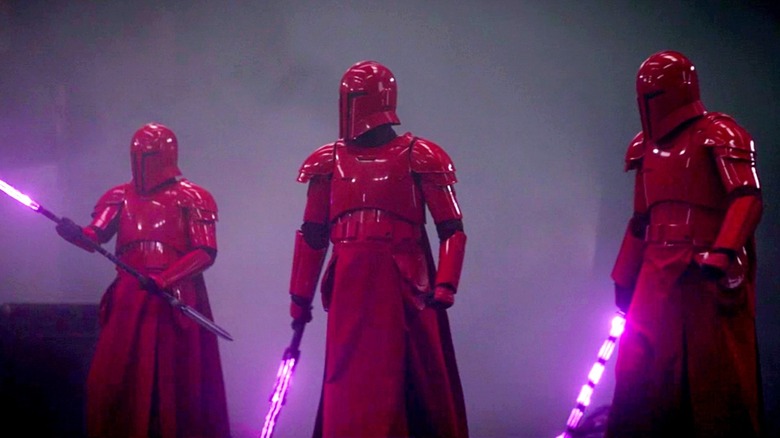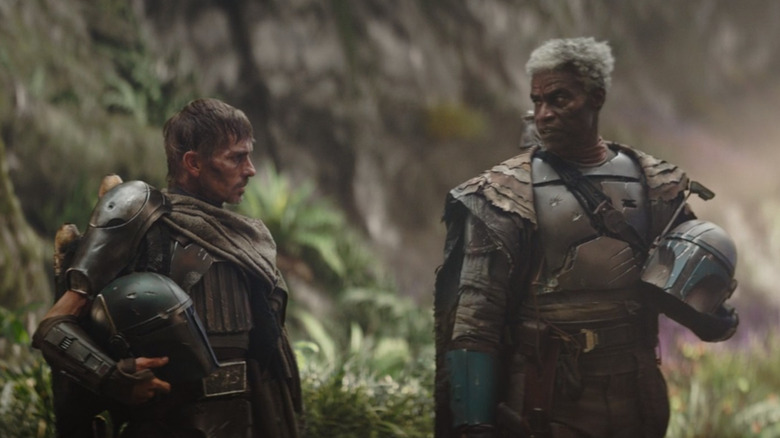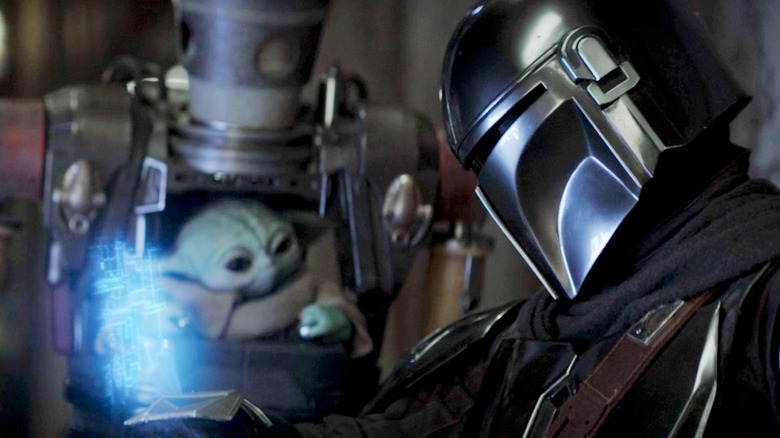The Ending Of The Mandalorian Season 3 Explained
Warning: This article contains spoilers for "The Mandalorian" Season 3, Episode 8.
From civil wars and Imperial occupation to genocidal purges, the Mandalorians of "Star Wars" have been through a lot. But by the end of "The Mandalorian" Season 3, a new day seems to be dawning. Din Djarin (Pedro Pascal) and Grogu reach a new stage in their relationship. Bo-Katan Kryze (Katee Sackhoff) achieves her lifelong dream of reuniting the Mandalorian clans. And most important of all, Mandalore itself is reclaimed by its people. This time, peace might actually be a reality.
The final two episodes of Season 3 form an action-packed climax for the show's biggest arcs, but the path there isn't exactly direct. "The Mandalorian" Season 3 is full of Easter eggs, celebrity guest stars, wacky side quests, and setups for future "Star Wars" projects. It's the least focused installment in the Disney+ series to date, but it's also littered with great fights and emotional moments. Season 3 has a lot of heart. It tries to cover a lot of terrain, and while it stumbles at points, it sticks the landing. We're far from the end of Din and Grogu's story, as Season 4 has already been confirmed. But the ending of "The Mandalorian" Season 3 still feels like the end of an era, and there's a lot to unpack.
Retaking Mandalore
For most of "The Mandalorian" Season 3, the endgame is clear. Finally, after multiple seasons and decades of in-universe oppression under the Empire, the Mandalorians are ready to retake their home. At the beginning of the show, Din shows little interest in the idea of restoring Mandalore, but it fits well in the current timeline of the show. While Din and Grogu are still central, Bo-Katan has gradually become a co-star along with them. By throwing her into the spotlight, Season 3 brings in storylines that have been running since "The Clone Wars." This history makes the season finale all the more impactful.
Thanks to a combined force of Bo-Katan's old mercenaries, the Children of the Watch, and a few Mandalorians who were abandoned on Mandalore, Moff Gideon falls. His army of stormtroopers cosplaying as Mandalorians is defeated, as are his Elite Praetorian Guards. Amid the destruction of his base, the finale offers hope for a bright future on Mandalore. The world's once lush landscape is glimpsed in underground cave gardens. At long last, the clans are united in a glorious mission to heal, not to conquer.
For Bo-Katan, rebuilding a society that's been devastated by eons of war is definitely not going to be easy. But it truly feels like the Mandalorians can do it this time — they can forge a new future for themselves and their descendants. Perhaps the Armorer was right earlier in the season; maybe Bo's discovery of a living Mythosaur truly indicates the beginning of a new age.
Moff Gideon's delusions of grandeur
Moff Gideon's delusional self-importance has stood in opposition to the Mandalorian people since Season 1. He's the ultimate colonialist: a man so infatuated with the idea of empire that he dresses up in a store-bought Darth Vader Halloween costume to make himself feel tall.
We've known since Season 1 that Mandalore was a pet project for Gideon. We know that he fancies himself a superior version of the Mandalorian warrior, even though his only maxed-out skills are monologuing and Zoom calls. By the end of "The Mandalorian" Season 3, Gideon's delusions of grandeur catch up to him, but not before he makes an absolute fool of himself.
Creating an army of Force-sensitive super soldiers equipped with Mandalorian weaponry? Not a bad plan. But when you use yourself — a middle-aged middle manager, in Gideon's case — as the template, it starts to fall apart. Where Palpatine represents the power-hungry evil of empire and Vader represents those it corrupts, Gideon represents the sad, desperate rubes who sell their souls for a lie of significance. He's every incel, desk jockey, and corporate kiss-up. He's the one who thinks he's the main character, because why else would everyone dislike him so intensely? In short, Gideon embodies the myth that colonial empire sells to its agents: that you are both capable and deserving of becoming an emperor unto yourself if you stand on the shoulders of someone else's culture.
It's apt, then, that Gideon's world comes crashing down on him, manifested in the form of a flaming Imperial light cruiser. Symbolism!
Stronger together
The Mandalorians are stronger than Gideon and his stormtroopers. They're more skilled, better trained, and more dedicated. These facts have never been in doubt, but they also haven't led to many wins in the past. The Empire has numbers, money, and beskar.
Bo-Katan leads her united Mandalorian front to victory at the end of Season 3, and it's that unitedness that's the key. All the skill and knee rockets (still weird) in the world won't prevail if infighting persists. At least, that's the message that "The Mandalorian" tries to drive home.
Bo says it herself while facing off against Gideon: "Mandalorians are stronger together." This isn't just a commentary on their past division in the show, but across all of the "Star Wars" canon. Dave Filoni's modern Mandalorian saga began in January of 2010 with the "Clone Wars" episode "The Mandalore Plot" — almost three years before Disney bought Lucasfilm. If you've been following the story since then, it's been a long journey. Civil wars led to a peaceful government, which was dismantled by terrorist attacks and political corruption. The planet was taken over by crime syndicates and renegade Sith, then thrown under the fist of the Empire.
For so long, the Mandalorians have battled one another and suffered the consequences. But in the "Mandalorian" Season 3 finale, it's their cooperation and shared vision that ultimately leads them to victory. Even in the final duel against Moff Gideon himself, it takes the combined efforts of Bo-Katan, Din, Grogu, and Axe Woves to finish him off. That's not a mark of Gideon's superior power, but rather a mark of just how strong unity can be.
The end of the Darksaber and the end of an era
Since "Star Wars: The Clone Wars," the Darksaber has been at the center of the Mandalorian story. An ancient weapon wielded by the first Mandalorian Jedi, Tarre Vizsla, it's supposedly meant to be held by the ruler of Mandalore. Only a successful fight to the death can earn someone the Darksaber, and only its power can unite the clans ... according to some.
In reality, the black blade has been more of a curse since it was introduced in "The Clone Wars." Darth Maul uses it to kill Duchess Satine Kryze, Moff Gideon uses it to oppress the Mandalorian people, and Bo-Katan's lack of claim to the sword erodes her reputation with her followers. So maybe it's for the best, and a little bit fitting, that the Darksaber is destroyed in the climactic battle with Gideon.
Perhaps, as Bo-Katan has repeatedly suggested, rules that force Mandalorians to kill each other aren't rules worth following. Perhaps the Darksaber didn't represent the strength of Mandalore, but the weakness of its people's unending desire for bloodshed. By destroying the weapon, Gideon may have actually set the Mandalorians free. It's a new era now — one where the possession of an ancient relic won't determine who's fit to rule.
Or, you know, they could fix it next season. That could happen too.
Din Grogu: Mandalorian apprentice
Grogu has always been both the greatest success of "The Mandalorian" and its biggest challenge. On the one hand, he's one of the best marketing ploys Disney has ever dreamed up — so cute that he makes many people forget just how pitifully the company has handled "Star Wars" of late. On the other hand, he's one of two main characters in this show and he can't speak a single word. How do you make a puppet designed to sell toys into a compelling character for multiple seasons? Give him a quirky, loveable dad and a bunch of solid loot drops.
Grogu may still be only half a character, but he works. Watching him grow and learn more about himself and the galaxy has always been a high point of the show. He demonstrates just how far he's come in the final battle on Mandalore, in which he saves Din from stormtroopers, fends off three Praetorian Guards, helps Bo-Katan defeat Moff Gideon, and protects the whole squad from a massive explosion. His Force shield technique is particularly striking because it echoes the end of "The Mandalorian" Season 1. Back then, it took all of Grogu's might just to stop a single flametrooper. Now, he can hold back the fires of a crashing star cruiser.
It's only fitting, then, that Season 3 ends with Grogu promoted from foundling to Mandalorian apprentice. And with that advancement in rank comes an even more important development: being officially adopted by Din Djarin and taking on the name Din Grogu. It's sweet, satisfying, and bound to give you a lump in the throat. Even amidst the frequent zaniness of Season 3, the little green guy keeps the heart of the show pumping.
Din Djarin: New Republic contractor
There comes a time in every bounty hunter's life when they have to make a choice. Do you keep pursuing the path of dangerous gigs and space food in search of fame and fortune? Or do you admit that your back's a little achy, and that you don't recover in the bacta tank as quickly as you used to, and that those long nights in the hyperspace lanes are downright lonely? For Din Djarin, the decision is easy — especially after Nevarro High Magistrate Greef Karga offers him a little homestead for free. In this galactic economy?
At the end of the "Mandalorian" Season 3 finale, Din tells New Republic Ranger Carson Teva that he wants a more reputable line of work now that he's a father. He proposes working as a freelance contractor for the New Republic, which would definitely be a step up from ordinary bounty hunting.
With this new job under his belt and a cute little house to raise Grogu in, Din's really come full circle. We first meet him in Season 1 running dangerous missions on Nevarro. The planet is a wretched hive of scum, villainy, and Imperial holdouts, and the Mandalorians live in the sewers. Now, at the end of Season 3, Din is living on the same planet, but things are quite different. His work has helped transform Nevarro into a thriving trade hub, and he has an official sanction from the galactic government to suss out and put away bad guys.
Life persists
If there is one prevailing theme in "The Mandalorian" Season 3, it's summed up midway through the finale. The captain of the survivors who've been living on Mandalore leads Bo-Katan and her crew to a safe haven — a cave teeming with wildlife. He tells Bo that they have been planting farms to restore the ecosystem, and when she asks how such a thing is possible on a barren planet, he responds simply: "Life persists." The sentiment worked in "Jurassic Park," and it works here, too. No matter how powerful evil may become, the natural balance of the universe will always find a way to fight back.
This theme underscores most of the season. Bo-Katan is alone and hopeless at the start after losing the Darksaber and her forces. But by reconnecting with her heritage, she finds new hope. Nevarro manages to become a peaceful world despite decades of Outer Rim chaos and Imperial violence. The Mythosaur, thought long to be extinct, rears its massive head at the sight of true Mandalorians. Even the bizarre side quest on Plazir-15 in Season 3, Episode 6 echoes this message. Given time, space, and the ability to heal, any community can become more than it was.
Evil festers in the shadows
The first two seasons of "The Mandalorian" focus squarely on Din's adventures. Most of the action takes place in the Outer Rim or the Mid Rim, and a handful of New Republic rangers are the only glimpse of core galactic society. All that changes in Season 3. We get an entire episode on Coruscant, numerous deep dives into the nature of post-Imperial politics, and a look behind the curtain at Grand Admiral Thrawn's impending return.
One message prevails through all of this: The New Republic isn't half as safe or secure as it would like to think. The amnesty program, meant to rehabilitate former Imperials, is full of holes, allowing for people like Elia Kane to gain New Republic access while still working for the Empire. The Outer Rim is far too large for the government to police or protect, and the so-called Shadow Council remains active in, well, the shadows.
All of this helps explain the rise of the First Order in the sequel trilogy. It might have seemed strange and even rushed in "The Force Awakens" when the First Order appeared on the scene and quickly destroyed half a dozen planets. But now, we see just how much careful scheming and New Republic inefficacy led to that moment. This is clearly a plotline that will be continued in the "Ahsoka" series and "The Mandalorian" Season 4, for better or worse.
A galaxy with room to grow
While the New Republic struggles and the Imperial Remnant schemes, the rest of the galaxy seems to be thriving. "The Mandalorian" Season 3 seems to argue that grassroots community projects, not massive governments, are the way forward, especially in the Outer Rim and the Mid Rim. Nevarro is the best example of this, turning saloons into schoolhouses and dangerous environments into hospitable homes. But we also see it on Plazir-15, and in a different way, on Mandalore.
An often-overlooked aspect of the "Star Wars" story is that the Republic truly was corrupt by the time Palpatine toppled it. The Senate failed to serve its constituents, the galactic core hoarded the riches of the galaxy, and there was rampant corruption. These ideas are alluded to in the prequels, but they're even clearer in "The Clone Wars." "The Mandalorian" Season 3 suggests that the New Republic isn't really much better. The galaxy is certainly improving now that it's out from under Palpatine's thumb, but it's the regular people fighting for their own localities, not the bigwigs on Coruscant, who make the difference. As the old Mandalorian captain says of the plants on Mandalore, all they need to thrive is room to grow.
What's next for Din and Grogu in The Mandalorian Season 4?
After retaking Mandalore, defeating Moff Gideon, and officially becoming a family, Din and Grogu have earned some time off at their new home on Nevarro. But "The Mandalorian" Season 4 is coming, and we already have some clues as to what it might hold.
Gideon may be gone, but the Imperial Remnant is still building strength in the far reaches of space. Grand Admiral Thrawn is set to return in "Ahsoka," and his campaign against the New Republic could spill into Season 4. Now that Din is a contractor for the galactic government, he could be called into action against Thrawn. And since Dave Filoni is now making a "Star Wars" movie to wrap up the so-called "Mandoverse" saga, it's likely that the shows will continue to overlap in big ways.
As for Mandalore itself, things look bright. The Armorer tells Din at the end of Season 3 that he must take Grogu on adventures now that he's his apprentice, which will likely keep the pair away from the homeworld for a while. A fresh run of episodic voyages likely awaits in Season 4, but we'll probably still get some visits to Bo-Katan's reconstruction efforts. The bigger question now isn't what "The Mandalorian" Season 4 will hold, but when it will arrive.
